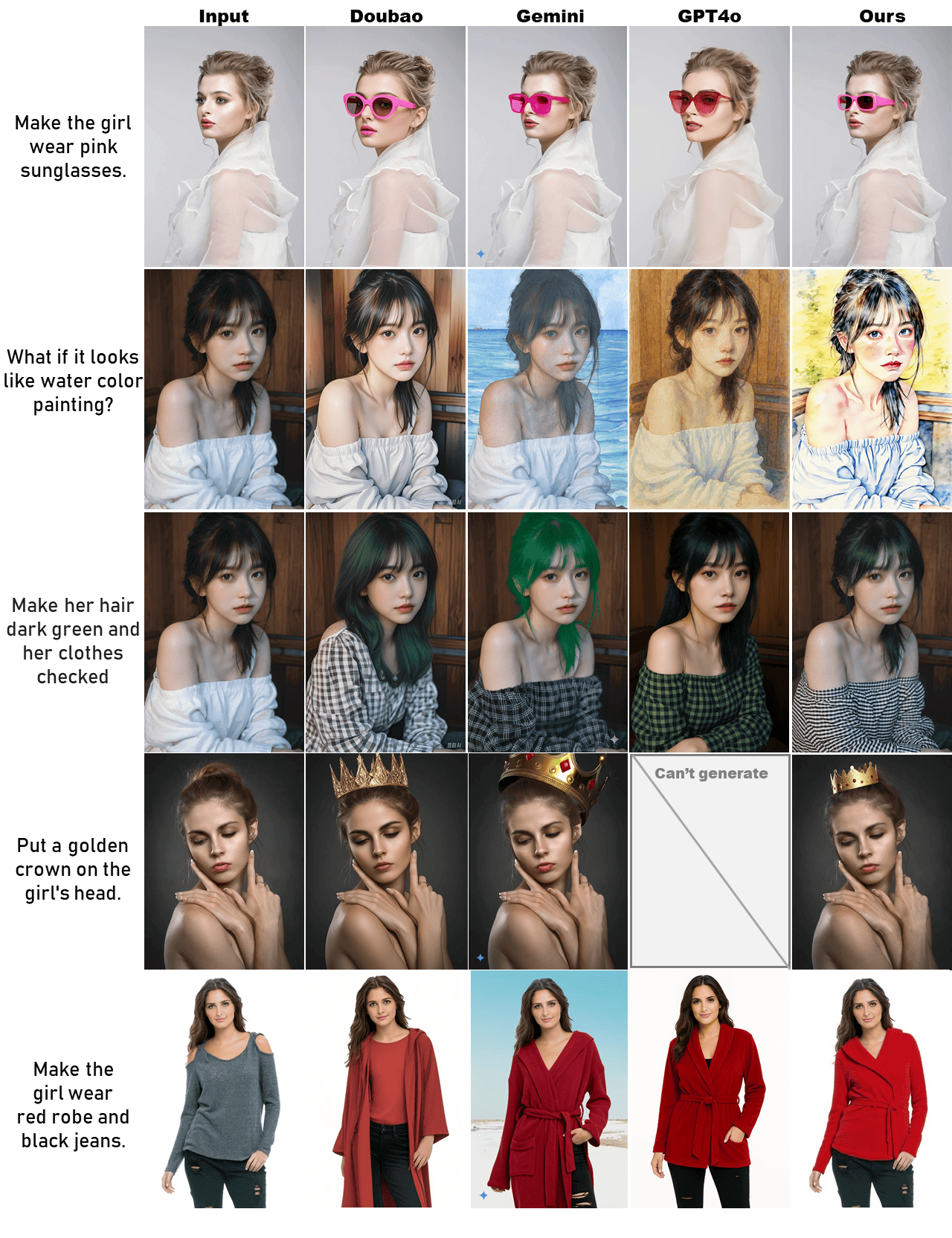In-Context Edit: Enabling Instructional Image Editing with In-Context Generation in Large Scale Diffusion Transformer

We present In-Context Edit, a novel approach that achieves state-of-the-art instruction-based editing using just 0.5% of the training data and 1% of the parameters required by prior SOTA methods. The first row illustrates a series of multi-turn edits, executed with high precision, while the second and third rows highlight diverse, visually impressive single-turn editing results from our method.
:open_book: For more visual results, go checkout our project page
This repository will contain the official implementation of ICEdit.
⚠️ Tips
If you encounter such a failure case, please try again with a different seed!
Our base model, FLUX, does not inherently support a wide range of styles, so a large portion of our dataset involves style transfer. As a result, the model may sometimes inexplicably change your artistic style.
Our training dataset is mostly targeted at realistic images. For non-realistic images, such as anime or blurry pictures, the success rate of the editing drop and could potentially affect the final image quality.
While the success rates for adding objects, modifying color attributes, applying style transfer, and changing backgrounds are high, the success rate for object removal is relatively lower due to the low quality of the OmniEdit removal dataset.
The current model is the one used in the experiments in the paper, trained with only 4 A800 GPUs (total batch_size = 2 x 2 x 4 = 16). In the future, we will enhance the dataset, and do scale-up, finally release a more powerful model.
To Do List
- Inference Code
- Inference-time Scaling with VLM
- Pretrained Weights
- More Inference Demos
- Gradio demo
- Comfy UI demo
- Training Code
🎆 News
- [2025/4/30] 🔥 We release the Huggingface Demo 🤗! Have a try!
- [2025/4/30] 🔥 We release the inference code and pretrained weights on Huggingface 🤗!
- [2025/4/30] 🔥 We release the paper on arXiv!
- [2025/4/29] We release the project page and demo video! Codes will be made available in next week~ Happy Labor Day!
💼 Installation
Conda environment setup
conda create -n icedit python=3.10
conda activate icedit
pip install -r requirements.txt
pip install -U huggingface_hub
Download pretrained weights
If you can connect to Huggingface, you don't need to download the weights. Otherwise, you need to download the weights to local.
Inference in bash (w/o VLM Inference-time Scaling)
Now you can have a try!
Our model can only edit images with a width of 512 pixels (there is no restriction on the height). If you pass in an image with a width other than 512 pixels, the model will automatically resize it to 512 pixels.
If you found the model failed to generate the expected results, please try to change the
--seedparameter. Inference-time Scaling with VLM can help much to improve the results.
python scripts/inference.py --image assets/girl.png \
--instruction "Make her hair dark green and her clothes checked." \
--seed 42 \
Editing a 512×768 image requires 35 GB of GPU memory. If you need to run on a system with 24 GB of GPU memory (for example, an NVIDIA RTX3090), you can add the --enable-model-cpu-offload parameter.
python scripts/inference.py --image assets/girl.png \
--instruction "Make her hair dark green and her clothes checked." \
--enable-model-cpu-offload
If you have downloaded the pretrained weights locally, please pass the parameters during inference, as in:
python scripts/inference.py --image assets/girl.png \
--instruction "Make her hair dark green and her clothes checked." \
--flux-path /path/to/flux.1-fill-dev \
--lora-path /path/to/ICEdit-MoE-LoRA
Inference in Gradio Demo
We provide a gradio demo for you to edit images in a more user-friendly way. You can run the following command to start the demo.
python scripts/gradio_demo.py --port 7860
Like the inference script, if you want to run the demo on a system with 24 GB of GPU memory, you can add the --enable-model-cpu-offload parameter. And if you have downloaded the pretrained weights locally, please pass the parameters during inference, as in:
python scripts/gradio_demo.py --port 7860 \
--flux-path /path/to/flux.1-fill-dev (optional) \
--lora-path /path/to/ICEdit-MoE-LoRA (optional) \
--enable-model-cpu-offload (optional) \
Then you can open the link in your browser to edit images.
🎨 Enjoy your editing!
Comparison with Commercial Models

Compared with commercial models such as Gemini and GPT-4o, our methods are comparable to and even superior to these commercial models in terms of character ID preservation and instruction following. We are more open-source than them, with lower costs, faster speed (it takes about 9 seconds to process one image), and powerful performance.
Bibtex
If this work is helpful for your research, please consider citing the following BibTeX entry.
@misc{zhang2025ICEdit,
title={In-Context Edit: Enabling Instructional Image Editing with In-Context Generation in Large Scale Diffusion Transformer},
author={Zechuan Zhang and Ji Xie and Yu Lu and Zongxin Yang and Yi Yang},
year={2025},
eprint={2504.20690},
archivePrefix={arXiv},
primaryClass={cs.CV},
url={https://arxiv.org/abs/2504.20690},
}
- Downloads last month
- 208
Model tree for sanaka87/ICEdit-MoE-LoRA
Base model
black-forest-labs/FLUX.1-Fill-dev